Related Research Articles

Rome is the capital city of Italy. It is also the capital of the Lazio region, the centre of the Metropolitan City of Rome Capital, and a special comune (municipality) named Comune di Roma Capitale. With 2,860,009 residents in 1,285 km2 (496.1 sq mi), Rome is the country's most populated comune and the third most populous city in the European Union by population within city limits. The Metropolitan City of Rome, with a population of 4,355,725 residents, is the most populous metropolitan city in Italy. Its metropolitan area is the third-most populous within Italy. Rome is located in the central-western portion of the Italian Peninsula, within Lazio (Latium), along the shores of the Tiber. Vatican City is an independent country inside the city boundaries of Rome, the only existing example of a country within a city. Rome is often referred to as the City of Seven Hills due to its geographic location, and also as the "Eternal City". Rome is generally considered to be the cradle of Western civilization and Western Christian culture, and the centre of the Catholic Church.
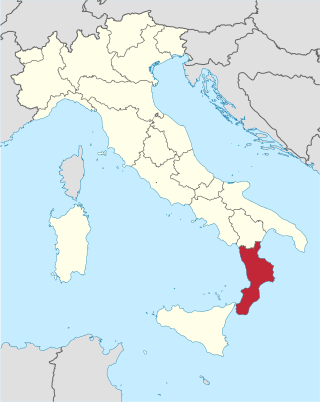
Calabria is a region in Southern Italy. It is a peninsula bordered by Basilicata to the north, the Ionian Sea to the east, the Strait of Messina to the southwest, which separates it from Sicily, and the Tyrrhenian Sea to the west. It has almost 2 million residents across a total area of 15,222 km2 (5,877 sq mi). Catanzaro is the region's capital.
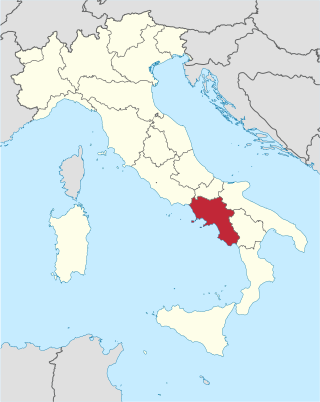
Campania is an administrative region of Italy; most of it is in the south-western portion of the Italian peninsula, but it also includes the small Phlegraean Islands and the island of Capri. The capital of the Campania region is Naples. As of 2018, the region had a population of around 5,820,000 people, making it Italy's third most populous region, and, with an area of 13,590 km2 (5,247 sq mi), its most densely populated region. Based on its GDP, Campania is also the most economically productive region in southern Italy and the 7th most productive in the whole country. Naples' urban area, which is in Campania, is the eighth most populous in the European Union. The region is home to 10 of the 58 UNESCO sites in Italy, including Pompeii and Herculaneum, the Royal Palace of Caserta, the Amalfi Coast, the Longobardian Church of Santa Sofia in Benevento and the Historic Centre of Naples. In addition, Campania's Mount Vesuvius is part of the UNESCO World Network of Biosphere Reserves.

Mount Vesuvius is a somma-stratovolcano located on the Gulf of Naples in Campania, Italy, about 9 km (5.6 mi) east of Naples and a short distance from the shore. It is one of several volcanoes forming the Campanian volcanic arc. Vesuvius consists of a large cone partially encircled by the steep rim of a summit caldera, resulting from the collapse of an earlier, much higher structure.

Sorrento is a town overlooking the Bay of Naples in Southern Italy. A popular tourist destination, Sorrento is located on the Sorrentine Peninsula at the south-eastern terminus of the Circumvesuviana rail line, within easy access from Naples and Pompei. The town is widely known for its small ceramics, lacework and marquetry (woodwork) shops.
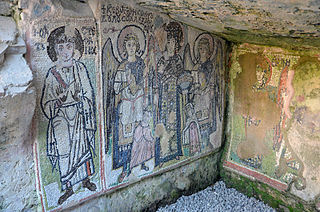
Durrës is the second-most-populous city of the Republic of Albania and seat of Durrës County and Durrës Municipality. It is one of Albania's oldest continuously inhabited cities, with roughly 2,500 years of recorded history. It is located on a flat plain along the Albanian Adriatic Sea Coast between the mouths of the Erzen and Ishëm at the southeastern corner of the Adriatic Sea. Durrës' climate is profoundly influenced by a seasonal Mediterranean climate.

Iseo is a town and comune in the province of Brescia, in Lombardy, Italy, on the south shore of Lake Iseo. It is bounded by the communes of Provaglio d'Iseo, Sulzano, Polaveno and Paratico.

The National Archaeological Museum of Naples is an important Italian archaeological museum, particularly for ancient Roman remains. Its collection includes works from Greek, Roman and Renaissance times, and especially Roman artifacts from the nearby Pompeii, Stabiae and Herculaneum sites. From 1816 to 1861, it was known as Real Museo Borbonico.

Castellammare di Stabia is a comune in the Metropolitan City of Naples, Campania region, in southern Italy. It is situated on the Bay of Naples about 30 km (19 mi) southeast of Naples, on the route to Sorrento.
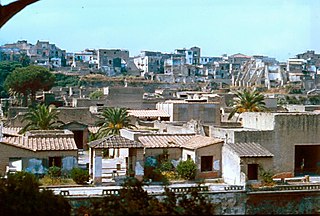
Ercolano is a town and comune in the Metropolitan City of Naples, Campania of Southern Italy. It lies at the western foot of Mount Vesuvius, on the Bay of Naples, just southeast of the city of Naples. The medieval town of Resina was built on the volcanic material left by the eruption of Vesuvius that destroyed the ancient city of Herculaneum, from which the present name is derived. Ercolano is a resort and the starting point for excursions to the excavations of Herculaneum and for the ascent of Vesuvius by bus. The town also manufactures leather goods, buttons, glass, and Lacryma Christi wine.

The Aqua Augusta, or Serino Aqueduct, was one of the largest, most complex and costliest aqueduct systems in the Roman world; it supplied water to at least eight ancient cities in the Bay of Naples including Pompeii and Herculaneum. This aqueduct was unlike any other of its time, being a regional network rather than being focused on one urban centre.

Pagani is a town and comune in Campania, Italy, administratively part of the Province of Salerno, in the region known as the Agro nocerino-sarnese. Pagani has a population of 35,834, as of 2016.

Boscoreale is an Italian comune (municipality) and town in the Metropolitan City of Naples, Campania, with a population of 27,457 in 2011. Located in the Vesuvius National Park, under the slopes of Mount Vesuvius, it is known for the fruit and vineyards of Lacryma Christi del Vesuvio. There is also a fine Vesuvian lava stone production.
Below are notable events in archaeology that occurred in 1950.
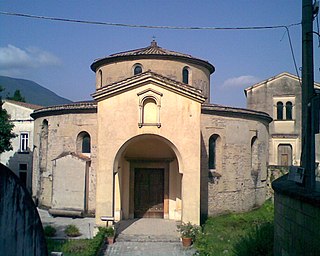
Nocera Superiore is a town and comune in the province of Salerno in the Campania region of south-western Italy.

The House of the Tragic Poet is a Roman house in Pompeii, Italy dating to the 2nd century BC. The house is famous for its elaborate mosaic floors and frescoes depicting scenes from Greek mythology.
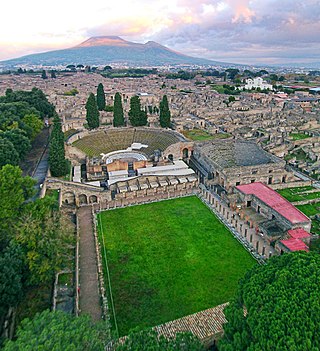
Pompeii was an ancient city in what is now the comune of Pompei near Naples in the Campania region of Italy. Along with Herculaneum, Stabiae, and many surrounding villas, the city was buried under 4 to 6 m of volcanic ash and pumice in the eruption of Mount Vesuvius in 79 AD.

Stabiae was an ancient city situated near the modern town of Castellammare di Stabia and approximately 4.5 km southwest of Pompeii. Like Pompeii, and being only 16 km (9.9 mi) from Mount Vesuvius, it was largely buried by tephra ash in 79 AD eruption of Mount Vesuvius, in this case at a shallower depth of up to 5 m.

Deliberate destruction and theft of cultural heritage have been conducted by the Islamic State (IS) since 2014 in Iraq, Syria, and to a lesser extent in Libya. The destruction targets various places of worship under IS control and ancient historical artifacts. In Iraq, between the fall of Mosul in June 2014 and February 2015, IS had plundered and destroyed at least 28 historical religious buildings. Valuable items from some buildings were looted in order to smuggle and sell them to foreigners to finance the running of the Islamic State.
The conservation and restoration of Pompeian frescoes describes the activities, methods, and techniques that have historically been and are currently being used to care for the preserved remains of the frescoes from the archeological site of Pompeii, Italy. The ancient city of Pompeii is famously known for its demise in A.D. 79 after the fatal eruption of Mount Vesuvius wiped out the population and buried the city beneath layers of compact lava material. In 1738, King Charles III or Charles of Bourbon, began explorations in Portici, Resina, Castellammare di Stabia, a Civita, where it was believed that the ancient cities of Pompeii, Stabiae, and Herculaneum were buried beneath. The first phase of the excavations at Pompeii started in 1748, which led to the first conservation and restoration efforts of the frescoes since their burial, and in 1764, open-air excavations began at Pompeii. Pompeii has a long history of excavation and restoration that began without a strong foundation or strategy. After centuries of cronyism, recurring financial shortages, and on-again-off-again restoration, the city's frescoes and structures were left in poor condition. In 1997, Pompeii was added to the UNESCO List of World Heritage Sites.
References
- ↑ "Restoring Ancient Stabiae Foundation". Vesuvian Institute. Archived from the original on 18 August 2016. Retrieved 2 August 2016.
- ↑ "History of the excavation of Stabiae". Soprintendenza Pompei. Archived from the original on 15 September 2016. Retrieved 2 August 2016.